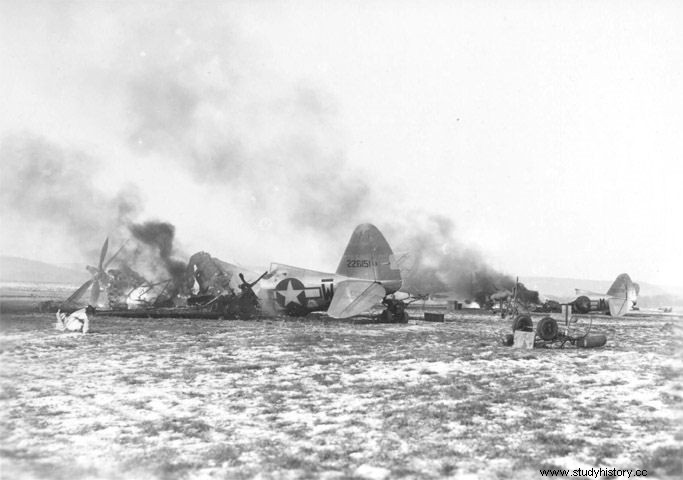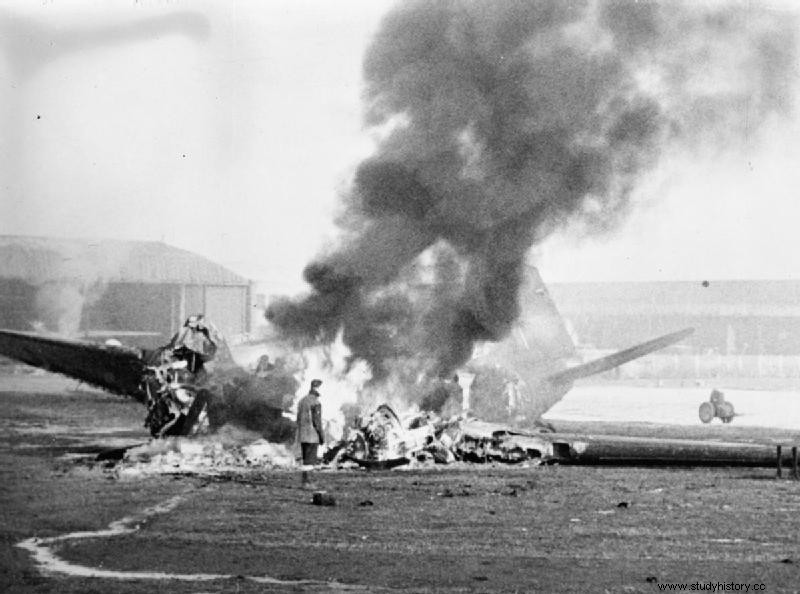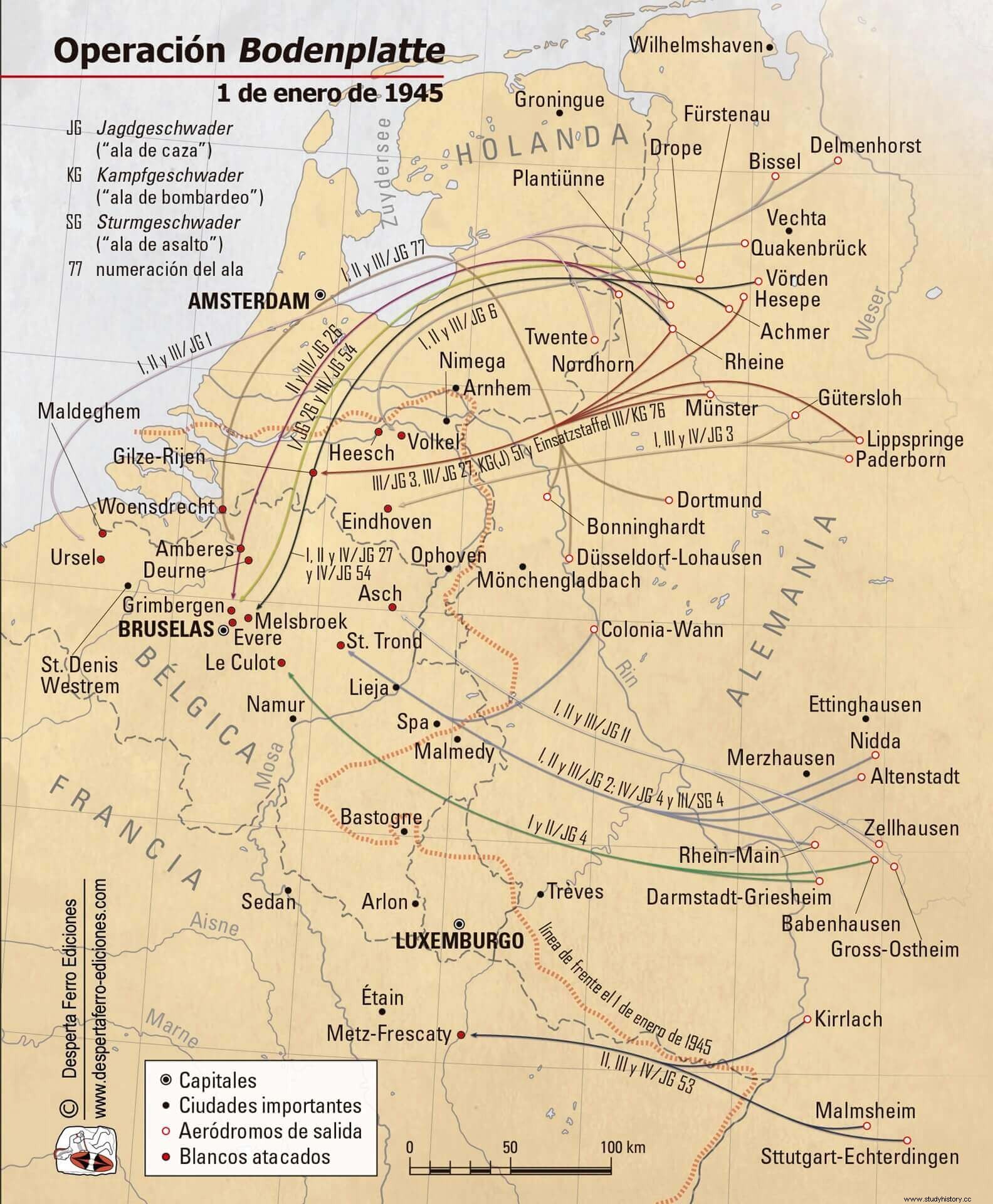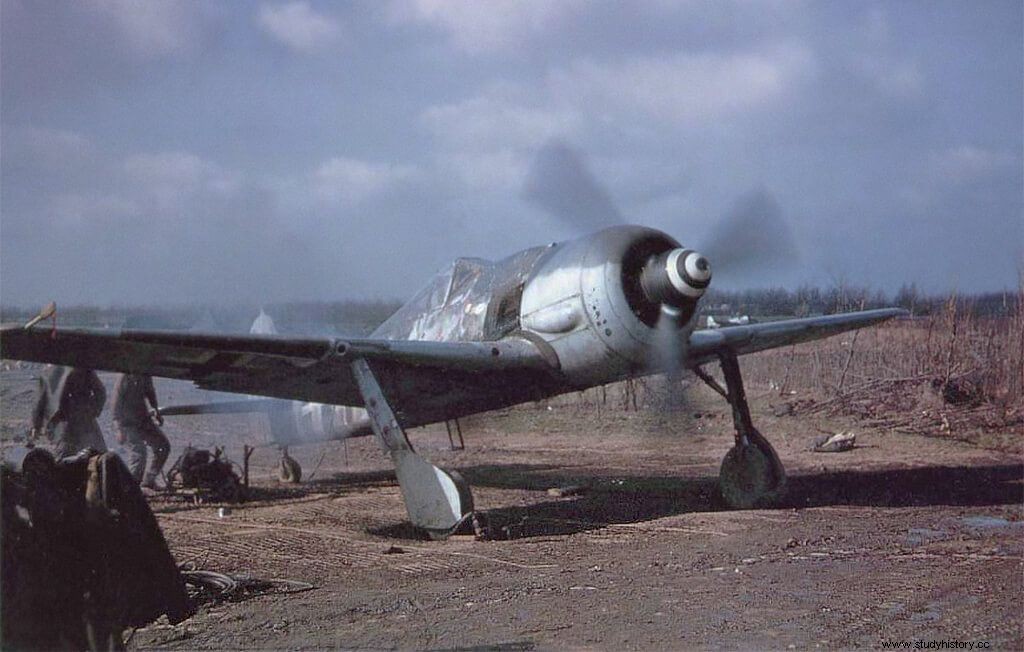
Orders remained orders, and to increase impact of the operation it was necessary to prohibit any flight that had no relation to it, inform the pilots and do what was necessary to put in operational status, during the night, as many planes as possible. Needless to say, the night hours were hectic for the mechanics, finally the 34 Gruppen (“air groups”) were to be able to deploy 900 aircraft, including 20 Me 262s from the Kampfgeschwader (J) 51 [N. del T.:Kampfgeschwader was the German name for the bomber wing, however, the (J) added to the name indicated that, although it was originally, it had been converted into a fighter wing]. According to OKW sources, within the framework of the Operation Bodenplatte 1035 flights were carried out on that January 1, 1945. In order to make up for the losses suffered during the combats of the previous days, it was also ordered that all the personnel of the Geschwader (“wings”) were employed in combat, including chiefs and members of their staffs who usually remained on the ground, which explains the huge casualties of experienced cadres that the Luftwaffe would suffer. , irreplaceable losses at this point in the war.
All this to fulfill a very clear order:attack the 19 allied airfields selected, all of them in the Netherlands, Belgium and near Metz, France, after flying low to the treetops to reach the targets between 9:00 and 10:00 without being detected. To achieve this, it was ordered to maintain strict radio silence and, to alleviate the deficiencies in instrument navigation capacity of the German pilots, which were very serious at this point in the war, each attack group was led by two Junkers 88 night fighters, whose pilots they still had the necessary knowledge. To return, it would be enough for them to follow the same route as on the way out, or fly east until they find an airfield in Germany.
The date of January 1, although one might think that the reaction capacity of the allied pilots would be somewhat lower after a "festive" night, had not been chosen for that reason, but depending on the weather forecasts on the objectives. The German pilots could have found themselves in the same circumstance as their enemies, but when they got up around 4:00 and 5:00 a.m. they did so in high spirits, after a night without a party since they knew the mission that awaited them. Despite the speed with which the operation was unleashed – only a few hours after the initial message – the preparations were up to the ambitions of the high command, although not everything went perfectly . The commanding general of the 16th Flak Division received the news too late to transmit it to all of its 50 batteries in time, so not all of them would be aware that they were going to be flown over by their own fighters and would not know how to correctly interpret the colored flares fired to guide the attackers and warn the anti-aircraft of their passage.
The attack
The operation began with thefirst night bombardment in history executed by jets , four Arado 234 of KG 76 against Brussels and Liège. Beyond the attack itself, whose impact was very low, the objective was to check without alerting the allies, already accustomed to attacks by these planes, that the weather was clear on the targets. As far as the attack itself is concerned, we are going to focus on the very different experiences of the different units.
For the Jagdeschwader 11 (“fighter wing”), on Asch, the attack was a clear failure. The two fighter groups (366th and 352nd) based at the airfield were due to fly an escort mission at 1100 hours, and had been on standby since 0800 hours when nearby Opphoven Airfield, the base of a British unit, was attacked. In the process of taking off, the Republic P-47 Thunderbolt were immediately sent into combat, where the Jagdeschwader lost 11 aircraft – among others the Oberstleutnant died Specht , in command of the unit – while the only allied aircraft shot down fell by mistake at the hands of a P-51 Mustang own self. The final result on both airfields was four Mustang destroyed plus one damaged, at Asch, for the 352nd Fighter Group, and seven fighters for the Belgian 350th Squadron plus several Douglas C-47s and one P-47 at Opphoven; against a final total of 28 of 65 apparatus lost for the Jagdeschwader 11, of which four aircraft were shot down on the way back. Among the 25 pilots who died, 40% of those who had the unit in the morning, we must also include the Hauptmann Von Fasong, head of the III Gruppe .

The objective of the 70 planes of the Jagdeschwader 6 was Volkel, where the Hawker Tempest were based of the 3. st Squadron. There, too, things went wrong for the Germans because the Ju 88 that was leading them made a navigation error that took them too far west and only 9 fighters managed to reach the target, over which 8 Tempest were already flying. . The end result was 8 attackers killed and minimal damage to infrastructure, so much so that barely an hour later the airfield was back in service. As for the rest of this German force, the 126th Wing shot down 24 aircraft, a third of JG 6, including that of their leader the Oberstleutnant Johannes Kogler, who was taken prisoner along with the Hauptmann Trost, head of the Gruppe YO; while the Hauptmann Kühle, of the Gruppe III, was killed.
Heinz Bär, one of the most prominent aces of the Luftwaffe , was the one in command of the Jagdeschwader 3, whose objective was Eindhoven . The 20 Messerschmitt 109 G (Me 109 G) that his unit had took off at 0830 hours to join a fleet of 70 aircraft. During the journey, some of the planes diverted to join JG 27 in the attack on Gilze-Rijen, bringing the total to 16 that attacked this airfield together with the Kampfgeschwader jets. 51 and 76.
The alarm issued by the Gilze-Rijen base was of little use in Eindhoven, where the 181st, 182nd, 137th and 247th Squadrons (with 20 aircraft each) were stationed, all of them quite worn by recent fighting as, among other casualties, they had lost the group commander and three of the four squad leaders. Although when Bär's planes arrived over the target there were 8 Hawker Typhoon of the 438th Squadron in the process of taking off, this time success smiled at the Germans and at the end of the day the balance was as follows:the 137th Squadron had 11 aircraft left, 8 to the 181st, 5 to the 247th. º and none to the 182nd. Witnesses to that combat would report that a 23-minute hell fell on Eindhoven and the infrastructures would not recover their full operation until mid-January. According to the Canadians, 144 aircraft were completely lost and 84 were damaged, all of them on the ground, six pilots were shot down and 40 men were killed while another 145 were wounded. During this action Bär claimed his 203rd and 204th aerial victories. As far as German casualties are concerned, 10 pilots did not return (killed or missing) and 6 were captured, giving a loss rate of 22%. /P>
The mission carried out by the Jagdgeschwader 1 “Oesau”, composed of 80 Me 109 and Focke-Wulf 190 (Fw 190) guided by two Ju 88 of the I/Nachtjagdgeschwader 2 (NJG 2), was targeting the Belgian airfields of Maldegem and Ursel for the Gruppen I and III, and Saint Denis-Wetrem for the II Gruppe . The planes deployed between 0810 and 0815 hours to head towards their target. The first incident took place while flying over The Hague, when the Flak A friend, who had not been warned, opened fire and shot down three aircraft, including that of the unit's commander-in-chief himself, who was forced to make a forced landing. The attack on Ursel was disappointing, as the twelve squadrons of Supermarine Spitfire based there had been called back to Britain and could only destroy one Boeing 17 (B-17) under repair, two Avro Lancaster and a de Havilland Mosquito . On Maldegen the problem was the mist, rather than the anti-aircraft fire, since the pieces had been removed a few days before. There the Germans destroyed a total of 13 Spitfire from the New Zealand 485th Squadron and one from the Belgian 349th, in exchange for two of their own aircraft. Finally, in Saint Denis-Westrem the three Polish squadrons (302nd, 308th and 317th) of the 131st Wing of the RAF had already taken off to go on their missions, so the fighting took place when the allies returned to the base, terrible duels that resulted in 32 Spitfire , a B-17 and a Short Stirling which ended up destroyed or damaged and with the death of two Polish pilots; but for this the Germans had to pay a high price, since 24 pilots, a third of the total, did not return, including the commander in chief of the I Gruppe. 12 of them died.
The Jagdgeschwader 2, bearing the now very famous name "Richtoffen", based north of Frankfurt and commanded by the Oberstleutnant Kurt Bühlingen, who had more than 100 victories against the Western Allies, attacked the planes of the 404th and 48th Fighter Groups at Saint Trond. The unit's 90 Fw 190s – some of which were of the D9 model, so new that they didn't even have their identification markings – took to the skies at 8:00 a.m.; shortly after they were joined by 8 Fw model F8 of the Sturmgeschwader 4 (SG, "assault wing") led by the Oberst Druschel , bearer of the Knight's Cross and with 800 ground support missions behind him. However, this would not save it from disappearing under the fire of the US anti-aircraft defense deployed around Aachen, very effective thanks to the low altitude at which the planes flew and which claimed three other aircraft from this wing. JG 2 was not spared from the catastrophe either, as it in turn lost twelve planes at the hands of the DCA, including the Hauptmann Schröder, head of the II Gruppe . If things had started badly, it was going to get worse, because the base they were supposed to attack had been warned by the air patrols, and the anti-aircraft fire took its toll there too. . The unappealable balance was 33 pilots shot down, 25 of them dead, a total of 40% of the troops for the Jagdgeschwader two; as well as 8 of the 30 pilots of the Sturmgeschwader 4. All this for only 12 P-47s destroyed.

Similar was the fate of the Jagdgeschwader 4 of the Major Michalski (Knight of the Iron Cross, with 70 victories). The 50 Me 190s and Fw 190s that made up the unit took off at 0810 hours and left for Le Culot guided by a Ju 88, which was soon shot down by anti-aircraft fire while flying over the Netherlands, after which the unit lost. The II Gruppe ended up attacking Saint Trond and other planes attacked the troops defending Bastogne, while the IV Gruppe he was on his way to attack Melsbroek without achieving practically anything. The unit lost 31 devices.
The region of Brussels was the target of four hunting parties, the III of the Jagdgeschwader 54 and I of the 26 were to attack Grinbergen airfield, while II and III of the Jagdgeschwader 26 would attack Evere's; 170 aircraft in all, an impressive force for the Luftwaffe then. The plan was that, once over the target, the fighters would make three attacks in batches of four aircraft. This formation also had to deal with own anti-aircraft fire , which shot down a dozen planes before they even sighted their target, while once upon it Polish Spitfire pilots of the 308th Squadron shot down at least six more. The result of the attacks on both airfields was disparate. At Grinbergen, almost empty, where they arrived at around 9:20 a.m., the Germans destroyed six planes, four of them B-17s, in exchange for the loss of 12 aircraft at the hands of the anti-aircraft defence; in Evere, however, things turned out very differently. Three fighter squadrons of the Royal Canadian Air Force were based there. , the 403rd, the 416th and the 421st, of which, when the Germans arrived at around 9:30, the 416th was in the process of taking off, although only the flight lieutenant would achieve it Harding, his boss, who managed to shoot down an Me 109 before falling too. Yes, the Spitfire were in flight of the 403rd, who were already leaving to fulfill their mission and had to return in a hurry to try to stop the carnage that was taking place. They could do little against 60 German planes, which razed the facilities , destroyed 11 Spitfire and damaged another 12 on the ground, only a small part of the no less than 120 aircraft (60 of them fighters and 32 heavy bombers) lost by the Allies, against 20 German pilots. The 421st Squadron didn't even get off the ground.
The Jagdgeschwader 77 had lost its commander, shot down and badly wounded over the Ardennes a short while ago, but still 100 Me 109 G14s and K4s were dispatched over Antwerp commanded by the Major Leie (Knight's Cross, with more than 100 victories), named on December 29. His plan was to attack in pairs of fighters, each making four passes, with the Typhoons of the 193rd, 197th, 257th and 263rd Squadrons and the Spitfire Frenchmen from the 341st and 345th Squadrons as targets, all of them trapped on the ground by the morning ice and tightly grouped by the mud around the runway; an ideal target. However, things did not go too well for this prestigious unit either. First, the Flak own shot down three devices, and more would fall later at the hands of the allied air defense; later, the dispersion of the planes was such that part of them attacked the Woendsrecht aerodrome, which was not only empty but was not their assigned objective; and also the II Gruppe it was lost off Antwerp and barely served any purpose . Finally, only part of the III Gruppe reached the assigned target, but the attack was disorganized and they only managed to damage 14 aircraft in exchange for four dead pilots, as many prisoners and two more missing.
Al Major Franzisket, Knight of the Iron Cross with 40 victories to his credit and commanding the Jagdgeschwader 27, he only had a little over thirty Me 109 G14 left in the Gruppen I and II, so the other two Gruppen departed in their wake of the wing, as well as the IV of the Jagdgeschwader 54, which added a total of 85 aircraft. Their target was Melsbroek airfield. , near Brussels, from which the Boeing 25 Mitchell had already departed of the 139th Wing to make an attack on Dasburg . This fact, added to the lack of skill of the German pilots, gave limited results :17 German pilots killed, missing or taken prisoner vs. 6 Spitfires , 6 Mosquitoes and 24 medium bombers destroyed.
The last target, and not the least, was in France. It was the Metz-Frescaty aerodrome , where the US 9th Air Force had just deployed, on December 27, the Typhoon of the 365th Fighter Group in anticipation of the expected German attack from Alsace that would materialize with the name of Operation Nordwind , which the allies knew thanks to Ultra . The detection of this air force had been an achievement of the German listening services that, although they did not have a machine that could decrypt enemy messages, they were capable of breaking the few security measures of some American transmissions.
The 50 Me 109 G14 and K4 of the Gruppen II, III and IV of the Jagdgeschwader 53 took off at 0800 in the direction of Metz in clear weather, which was fortunate because the Ju 88 that was supposed to guide them had been grounded due to a breakdown. Beyond Kaiserslautern, a patrol of P-47s fell on the II Gruppe , which lost 9 fighters in an instant –no human losses– and had to return to base because they had dumped their auxiliary fuel tanks in order to fight. The others arrived over the objective at 9:30 a.m., where some 40 P-47s and a powerful anti-aircraft defense were waiting for them, lined up. that 8 Me 109s would be collected for the 30 fighters destroyed or disabled on the ground, but there were no Allied aircraft in the air. By the time the 24 fighters from the 387th and 388th Squadrons were able to return to their base, the Germans had already left. In total, they mourned the loss of 14 pilots on this mission, and at the end of the day only 30 would still be able to fly.
The evaluation
As it happened with the ground attack launched on December 16th, in terms of the element of surprise, Bodenplatte it was all a success; the Germans had managed to execute 1,035 sorties (or 900 aircraft took part in it, according to sources), despite the losses suffered during the previous days over the Ardennes. However, this was the only achievement, or almost, of the operation. To begin with, 10 of the 33 fighter groups dispatched failed to find their targets, two attacked airfields that were not in service, and nine launched attacks with little success. Also, the Flak , not always informed, was responsible for too many “friendly fire” kills , both on the way out and on the way back. The failure of this operation it was also because, despite the predictable hangover, many Allied airmen had already taken off when the Germans arrived. Initially it was expected that these would arrive earlier on their targets, but various reasons, mainly related to the lack of visibility, delayed them for up to an hour, preventing them from finding their targets on the ground and forcing them to face, at some points, a strong concentration of enemies already in flight.

Although Allied losses are not to be snubbed either, German casualties made this operation a disaster for the Luftwaffe , bolstered by the former's ability to quickly replace lost aircraft—within one to two weeks, and as little as 24 hours for the U.S. 9th Air Force—and sustain their air effort, in part because they lost few pilots as most of the planes, 300, were destroyed on the ground, against 70 shot down in flight (according to Parker). Other figures speak of 144 RAF aircraft destroyed and 84 damaged, and 134 USAAF aircraft destroyed plus 70 shot down in air combat (Werner Girbing) or 305 aircraft destroyed on the ground, 31 shot down and 190 damaged (Manrho and Putz). /P>
As we have said, for the German Air Force the result was very different. Although the magnitude of the losses suffered by the Germans is still disputed, the figures are around 300 aircraft (85 of them at the hands of the Flak own) and 214 pilots dead, prisoners or missing, to which must be added 18 wounded, according to Parker; 137 aircraft destroyed (plus 100 by the Flak ) and 151 pilots killed and 63 taken prisoner, according to Werner Girbing; and 280 aircraft lost and 69 damaged, as well as 213 pilots killed and 21 wounded according to Manrho and Putz, who do not give a number of aircraft shot down by friendly anti-aircraft fire. Percentagewise, the arc goes from 10% suffered by the Jagdgeschwader 77 to 45% of the Jagdgeschwader 4; Qualitatively, 3 wing commanders, 6 group commanders and 11 squadron commanders were lost in that relentless bloodletting, an irreplaceable source of experience.
These casualties, added to the other problems facing the Luftwaffe , turned this action into the last allied mishap caused by the German fighter, already greatly diminished for months due to the constant allied bombing raids. The best example of the final ineffectiveness of Operation Bodenplatte was that that same afternoon the P-47s based in Metz, one of the most damaged airfields, were already attacking the German railway facilities again.
Bibliography
- Girbig, W. (2004):Six Months to Oblivion:The Defeat of the Luftwaffe Fighter Force over the Western Front 1944/45 . Lancaster:Schiffer Publishing.
- Manrho, J.; Putz, R. (2010):Bodenplatte:The Luftwaffe's Last Hope. Mechanicsburg:Stackpole Books.
- Parker, D.S. (1998):To Win the Winter Sky:The Air War over the Ardennes 1944-1945. Boston:Da Capo Press.
